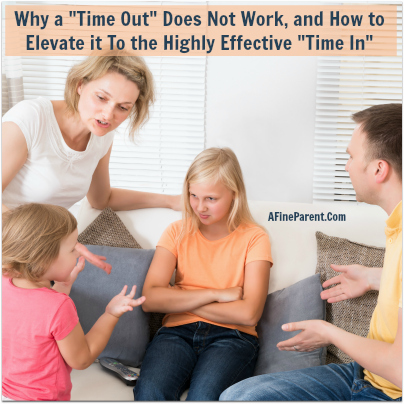 It’s been one of those afternoons. Your child has been acting out over and over again.
It’s been one of those afternoons. Your child has been acting out over and over again.
You have asked nicely for him to do better. You have issued a warning, and used your best “I mean it” kind of voice.
Hoping your message got through, you get back to what you were trying to accomplish when you hear “Hey that’s MY toy. Give it back!”
Frustration levels reach high alert.
You walk in just in time to see one child grabbing a toy away and the toddler now starting to cry.
That’s it. You’re done. It’s time for a time out.
You set a timer, place your child on a chair and walk away to console the little one. Five minutes later the two are back to fighting again.
What gives?
Why didn’t the Time Out make a difference?
Even though you gave your child a time out as a chance to cool down, things didn’t get better at all.
Your child is now half crying and half yelling. Not only is he mad at the baby, but he is now also mad at you! And is absolutely not willing to follow any of your requests.
Let’s talk about why time out failed…
Time out used to sound like the perfect fix for little kid infractions.
Don’t listen to mom, go to time out.
Throw food on the floor, go to time out.
Can’t play nice with your brother, go to time out.
Time outs aren’t exactly modern. Having started somewhere around the 1960s, and vastly popular in the 1990’s Time Out used to be considered a very helpful practice for managing misbehavior.
Giving a child a time out was meant to substitute harsher punishments such as hurting children with rulers and paddles.
The main idea behind Time Out is actually quite good.
It is supposed to give parents and children a time to calm down, think and then act better.
But just like the car seats from the 1960s aren’t reliable or usable these days, Time Outs work better if you give them an upgrade.
The steps below can be used for transforming the old version of time outs into a better, more brain and developmentally friendly Time In.
Many decades of research in the field of child development, self-regulation and neuroscience tell us that isolating children in time out is not the best way to help children learn how to behave well. You can read more about it here, here and here.
 It was once believed that withholding attention was necessary to make children behave better. Pediatric psychologist and author of the book Beyond Behaviors: Using Brain Science and Compassion to Understand and Solve Children’s Behavioral Challenges Mona Delahooke explains however that:
It was once believed that withholding attention was necessary to make children behave better. Pediatric psychologist and author of the book Beyond Behaviors: Using Brain Science and Compassion to Understand and Solve Children’s Behavioral Challenges Mona Delahooke explains however that:
“When we see a behavior that is problematic or confusing, the first question we should ask isn’t “How do we get rid of it?” but rather “What is this telling us about the child?”
 Does your child’s tough behaviors leave you feeling confused? You are not alone! We partnered with Dr. Mona Delahooke, licensed clinical psychologist and best-selling author, in the Understanding Behaviors Masterclass, to better understand the difference between “top down” and “bottom up” behaviors, and why our own self-compassion and self-regulation matter so much.
Does your child’s tough behaviors leave you feeling confused? You are not alone! We partnered with Dr. Mona Delahooke, licensed clinical psychologist and best-selling author, in the Understanding Behaviors Masterclass, to better understand the difference between “top down” and “bottom up” behaviors, and why our own self-compassion and self-regulation matter so much.
This packed masterclass is one of the 70+ masterclasses you get when you join the AFineParent Academy today. Click here to learn more.
Children need emotional support and a strong bond with adults in their life in order to develop self-control and awareness of their own behaviors.
Respectful and kind attention is not a reward but necessary to help children feel safe.
A Time In takes the basic principle of giving parents and children a chance to reset but elevates it to a way that helps children feel safe.
 If the aim of Time Out was to stop behaviors, Time In is instead an opportunity to understand and to support your child to choose better behavior in the future.
If the aim of Time Out was to stop behaviors, Time In is instead an opportunity to understand and to support your child to choose better behavior in the future.
And in the process, you gain an understanding of the situation and can guide your child to better choices.
A quick disclaimer here – Because the aim of Time In is to help your child reset and make better choices, it’s not necessarily a fast, three-minute process like a time out would have been.
Time In might take a few extra minutes, but in that time it helps children develop self-regulation skills. And that ability to understand and manage their own actions and reactions serves them well for the rest of their lives!
Four Steps for Elevating a Time Out into a Time In
1. Substitute warnings with warm leadership
If your child is behaving in a way that makes you believe they need a time out (like not following directions), you can try a Time In.
Instead of issuing a warning like “stop doing that or you will be in trouble” or announcing sternly “time out now!”, approach your child calmly and kindly guide the process.
For example, you could start by walking over to your child and try to read the situation.
Ask yourself:
“How is my child feeling?”
“How can I help my child feel and do better?”
Being curious and open to helping allows you to decide where it would be best to take a time in.
Depending on the situation you may be able to stay right where your child is. In other situations you may prefer to help your child move to a calmer, neutral location.
Some parents even set up a dedicated calm down corner in their house that can double as time in spots, or use a Time-In toolkit to help them get started.

2. Ditch the Timer and Try Connection
Get curious about the situation and your child’s behavior and see if they will talk to you about what is happening. If your child isn’t ready to talk, you can state what you see or simply wait a while.
If using time in is new for you, there is no harm in trying out a few different ways of approaching the process. Sitting on a couch together with a toddler often works well. Some children need that extra step of walking away with your help to a different location, like stepping outdoors. A spontaneous time in on the kitchen floor could be just what your child needs.
It might help to think of Time In as pressing the pause button so you can help your child calm down.
Contrary to real estate, location isn’t important. What matters is that you be present and willing to take time.
3. Leaving and Lecturing becomes Limits and Listening
When children are worked up and acting out they are not at all ready to listen to long lectures on everything they have done badly.
Misbehavior is a clear sign your child is in distress and needs your guidance.
Stay close and state one clear limit. “I don’t want you to grab toys from your brother.”
Your child might cry about this or become upset. This is normal behavior and a sign that your child is trying to process his own feelings.
Truth time: This step requires a lot of patience.
If you are beginning to get triggered, remember that your child is little. They are having a hard time and their emotional reactions are not meant as a personal attack on you.
4. After Connection It’s time for Correction
When you notice your child is calm and ready to listen you can offer a short and helpful correction.
For example, if there was fighting over a toy you might say, “You can ask for the toy back or come get me for help.”
Share with your child in a few words what you wish to see next time around. If your child is chatty you can also ask them to share with you what they thought wasn’t working before.
 This can be a good step in understanding what your child needs to meet your expectations.
This can be a good step in understanding what your child needs to meet your expectations.
It may take several times before you and your child find your best “time in groove.”
Time In is not a one size fix all solution for handling unwanted behaviors. You might find some of these other parenting tools from my book 12 Alternatives to Timeouts helpful as well:
- Setting a simple and clear limit and following through can redirect children to make better choices.
- A daily dose of Special time can prevent much misbehavior from even showing up.
- Giving children simple, actionable choices can also be very helpful and a first step before using a time in.
Something Worth Knowing About Time In
Over time, your child can transition to taking a calming break on their own! Using time in gives your child a chance to learn in a loving and positive way what to do when they feel frustrated, angry, upset or overwhelmed.
 Want to learn more about Time-Ins and how they may work for you and your child? We partnered with Ariadne Brill, certified Positive Discipline Parenting Educator and author, in the Time-In Masterclass, to better understand how time-ins can help reduce power struggles and increase communication.
Want to learn more about Time-Ins and how they may work for you and your child? We partnered with Ariadne Brill, certified Positive Discipline Parenting Educator and author, in the Time-In Masterclass, to better understand how time-ins can help reduce power struggles and increase communication.
This packed masterclass is one of the 70+ masterclasses you get when you join the AFineParent Academy today. Click here to learn more.
The 2-Minute Action Plan for Fine Parents
For our quick contemplation questions today, let’s try these:
- Did your parents use Timeouts with you? How did you feel when you were sent to the corner on your own? Did you ever really feel true remorse and the need to change your behavior?
- How often do you use Timeouts in your family now? Does it work? Has its effectiveness reduced as your child grows up? Do you think it will still be effective when your child is a teen?
- Imagine your child is upset or frustrated… How do you wish they will handle those situations? What are you doing at the moment to help them get there?
The Ongoing Action Plan for Fine Parents
Over the next week try this
- If you have never tried a Time In commit to giving it a shot over the next week
- Plan ahead: Write a list of any challenging behaviors that might benefit from taking a time in.
- Reflect: How will you help your child feel well before you talk about what needs to change?
- Look back at Step Four: What words can you use to offer short, actionable corrections that lead to better behavior?
- Keep in Mind: Time In is a great way for children to learn calming skills, try to model the very behaviors you wish to see.
This article on the differences between Time Out and Time In is incredibly insightful! It’s fascinating to learn how Time In can help children feel safe and understood, rather than isolated. The emphasis on understanding the root cause of behaviors and supporting children in making better choices is very enlightening.
Over time, your child can transition to taking a calming break on their own! Using time in gives your child a chance to learn in a loving and positive way what to do when they feel frustrated, angry, upset or overwhelmed.
nice blog
http://geniustemple.com/